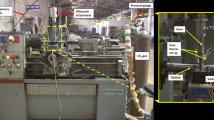Abstract
As one new type alloy, titanium alloy TC21 is difficult to cut. To investigate the machinability, the oblique cutting process for TC21 alloy has been investigated deeply. In the study, one 3D finite element model (FEM) of oblique cutting was presented to simulate the oblique turning process of TC21 alloy. In the oblique cutting simulation of TC21 alloy, Johnson-Cook material law has been adopted. Through the simulation, stress, and temperature, residual stress distribution and cutting force in the oblique cutting of TC21 alloy was obtained. At the same time, the effect of tool angle on the cutting force and residual stress in the oblique cutting of TC21 alloy has been analyzed detailedly. In addition, the simulation results have been verified by the oblique cutting tests and the residual stress tests.
Similar content being viewed by others
References
Kim JS, Jin WK, Sang WL (2017) Experimental characterization on micro-end milling of titanium alloy using nanofluid minimum quantity lubrication with chilly gas. Int J Adv Manuf Technol 91(5):1–9
Rahman M, Wang ZG, Wong YS (2006) A review on high-speed machining of titanium alloys. JSME Int J 49(1):11–20
Zhu Z, Sun J, Li J (2016) Investigation on the influence of tool wear upon chip morphology in end milling titanium alloy Ti6Al4V. Int J Adv Manuf Technol 83(9–12):1–9
Khanna N, Sangwan KS (2013) Machinability study of alpha/beta and beta titanium alloys in different; heat treatment conditions. Proc Inst Mech Eng B J Eng 227(3):357–361
Armendia M, Osborne P, Garay A, Belloso J, Turner S (2012) Influence of heat treatment on the machinability of titanium alloys. Mater Manuf Process 27(4):457–461
Patil S, Kekade S, Pawar P, Pawar S, Singh R (2016) Effect of coolant pressure on machinability of titanium alloy Ti6Al4V. Appl Mech Mater 826:82–87
Feng J, Sun Z, Jiang Z, Yang L (2016) Identification of chatter in milling of Ti-6Al-4V titanium alloy thin-walled workpieces based on cutting force signals and surface topography. Int J Adv Manuf Technol 82(9–12):1909–1920
Wang BS, Zuo JM, Wang ML, Hou JM (2012) Prediction of milling force based on numerical simulation of oblique cutting. Mater Manuf Process 27(10):1011–1016
Özel T, Thepsonthi T, Ulutan D, Kaftanoglu B (2011) Experiments and finite element simulations on micro-milling of Ti–6Al–4V alloy with uncoated and cBN coated micro-tools. CIRP Ann Manu Technol 60(1):85–88
Ali MH, Ansari MNM, Pang JS (2013) Finite element modeling to predict the effect of nose radius on the equivalent strain (PEEQ) for titanium alloy (Ti-6Al-4V). Eng Technol 7(2):83–87
Thepsonthi T, Özel T (2013) Experimental and finite element simulation based investigations on micro-milling Ti-6Al-4V titanium alloy: effects of CBN coating on tool wear. J Mater Process Technol 213(4):532–542
Zhang Y, Mabrouki T, Neliasa D, Courbona C, Rechb J, Gong Y (2012) Cutting simulation capabilities based on crystal plasticity theory and discrete cohesive elements. J Mater Process Technol 212(4):936–953
Sima M, Özel T (2010) Modified material constitutive models for serrated chip formation simulations and experimental validation in machining of titanium alloy Ti–6Al–4V. Int J Mach Tool Manu 50(11):943–960
Afazov SM, Ratchev SM, Segal J (2010) Modelling and simulation of micro-milling cutting forces. J Mater Process Technol 210(15):2154–2162
Wu HB, To S (2015) Serrated chip formation and their adiabatic analysis by using the constitutive model of titanium alloy in high speed cutting. J Alloy Compd 629:368–373
Wu HB, Zhang SJ (2014) 3D FEM simulation of milling process for titanium alloy Ti6Al4V. Int J Adv Manuf Technol 71(5–8):1319–1326
Johnson R, Cook WK (1983) A constitutive model and data for metals subjected to large strains high strain rates and high temperatures. The 7th International Symposium on Balistics. The Hague:541–547
Zorev NN (1963) Inter-relationship between shear processes occurring along tool face and shear plane in metal cutting. Inter Res Prod Eng, ASME: 42–49
Funding
This research was supported by the Zhejiang Provincial Natural Science Foundation of China (grant no. LY16E050008) and Ningbo Natural Science Foundation of China (grant no. 2016A610203).
Author information
Authors and Affiliations
Corresponding author
Rights and permissions
About this article
Cite this article
Zhang, X., Wu, H. Effect of tool angle on cutting force and residual stress in the oblique cutting of TC21 alloy. Int J Adv Manuf Technol 98, 791–797 (2018). https://doi.org/10.1007/s00170-018-2324-z
Received:
Accepted:
Published:
Issue Date:
DOI: https://doi.org/10.1007/s00170-018-2324-z




